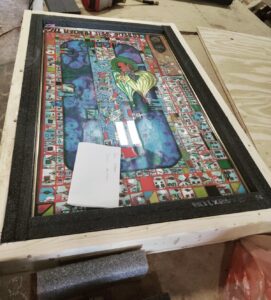If possible, you should personally transport and install your artwork for your customer now that you have sold it to ensure it is kept in the best possible condition. Your area of expertise as an artist is producing art. Therefore, the shipping procedure might be a confusing issue for you.
However, once you have completed a transaction with a foreign customer, you must see that it is delivered quickly and securely to them.
Custom Crating and Logistics gained a lot of expertise in packaging and transporting works of art of different sizes and shapes while working in a gallery, both domestically and abroad. It is necessary to ensure that the artwork is expertly wrapped and carefully secured for shipping.
We want to give you some guidelines we have picked up over the years because there are many factors to consider in this process.
Here’s how to send artwork safely and securely so that it reaches its destination in the best possible shape.
 Proper Packaging Of Your Art:
Proper Packaging Of Your Art:
During the process of shipping your artwork internationally, take extra care of it to prevent it from any damage. At the same time, your package should appear polished and deserving of the masterpiece within.
When it comes to safe delivery, good packing is essential. You must appropriately box your artwork to guard against any transit-related damage. It does not, however, obligate you to use excessive packaging that gives the impression of being bulky. Proper packing is essential to projecting a professional image and reducing delivery expenses.
Here are some tips for packing paintings for shipping them internationally:
Determine the size of your painting:
To decide what size box, tube, crate, or shipping container you will need, measure the length, height, and breadth of your painting. You may figure out shipping expenses using the dimensional weight, the ratio between the volume of a shipment’s required space and weight.
Required Tools:
You’ll require the following in addition to an acceptable container:
- To cut cardboard, use a sharp knife or box cutter.
- Pencil or marker
- T-square cuts may be made by using tape.
- Using a box sizer to fold the cardboard
 Protect the surface of the painting:
Protect the surface of the painting:
Be delicate and cautious when handling your artwork, especially the work surface. To prevent scuffs and scratches, properly cushion it with foam, cloth, bubble wrap, or cardboard.
Artwork is shielded from dust and moisture by glassine paper. Your artwork should be completely glassed and taped on all sides and corners. When rolling paintings for shipment in a tube, provide two inches of additional room on each side.
An oil painting, an art print, or a canvas can be protected from scratches with plastic palette wrap by acting as a protective layer. Choose extra broad rolls and wrap canvases in foil at least 3.5 millimeters thick.
Glassine paper:
Canvases can be protected from dust and moisture using glassine paper of archival grade. Your painting may be completely enclosed on all sides and edges with glassine, then taped together using artist’s tape. Glassine paper can also serve as protection while rolling a painting. Your painting should be placed on glassine paper at least 2 inches bigger on all sides.
Plastic Wrap:
Additionally, you may use plastic palette wrap as a covering to shield your canvases, oil paintings, and art prints from damage when being relocated. Make sure you wrap canvas artwork in foil at least 3.5mm thick.
Protect the glass:
If the glass breaks during shipment, painter’s tape or a thick layer of plastic wrap can help prevent punctures.
Protect against breakage and damage to the glass frames while framing artwork. If you have painter’s tape, apply it in the shape of a star (basically two X shapes which overlap at the center). Alternatively, a thin covering of cling film or plastic wrap will do. In the unlikely event that the glass breaks, tape or plastic wrap, make sure the pieces won’t fall off and pierce your artwork.
Secure the corners of the painting:
Corners need special protection since they are particularly prone to harm. Framed and unframed mounted artwork will be kept secure using cardboard corner protectors.
Use of Bubble Wrap:
Along with filling space in the package, bubble wrap also protects your artwork by cushioning it. To further protect against moisture, use at least two inches of wrap and tape the corners.
Bubble wrap is one of the best packing materials. A great approach to shield your artwork from harm is to cover it in many layers of bubble wrap. Make sure to lay the wrap that the bubbles face outward to avoid any unwanted imprints on your artwork.
Make sure to cover your artwork with at least 2 inches of bubble wrap on all its surfaces, edges, and corners. Finally, seal all the bubble wrap’s seams using packing tape to further insulate against moisture.
Filling Voids:
Movement and friction are two of the most harmful factors when shipping fragile things. Fill empty spaces in your container with bubble wrap to ensure that your artwork travels as little as possible. Utilize packaging tape instead of packing peanuts since they tend to collect at the bottom and expose the top edges.
Sandwich your painting:
Sandwich your bubble-wrapped artwork between two pieces of foam board with 0.5 inches thickness for protection. The foam boards may then be taped to create a “sandwich” with your painting.
Using packaging tape for sealing:
You’ll need to use high-quality packaging tape to seal the container after wrapping and packing your artwork for delivery. Ideal tape is pressure-sensitive poly tape. Don’t use cell phones or duct tape since these aren’t strong enough for shipping.
Choosing an expert shipping company:
When sending large paintings, get in touch with shipping firms to see whether they provide expert packing and shipping services at a discounted fee. You may typically save time and money by combining art shipping options.
Custom Crating and Logistics provides the best service to ship and pack your paintings securely internationally.
Preparing Customs and Other Documents:
Dealing with customs is one of the most frightening parts of selling your work abroad. When you sell your paintings through an art gallery, they will take care of the customs procedures. However, you must make the papers if you are handling the delivery.
Any errors on the declaration paperwork might result in a returned shipment or a delayed delivery, which would make your client dissatisfied.
Keeping oneself informed about the customs process and the necessary documentation may greatly ease your load. The most crucial paperwork for exporting artwork is shown below.
Custom Declaration:
Any commercial cargo must have a customs declaration. Depending on the value of the artwork, two distinct customs forms are often required.
Check if your art qualifies as higher or lower value art classification, and then select the proper customs declaration.
Export Invoice:
This paper is necessary for shipping fine art outside a customs union. When selling art, use a commercial invoice; if the artwork is for an exhibition, use a proforma invoice. Attach an imported invoice for the return trip home if you want your work returned.
All artwork must be transmitted to a nation outside the customs union with an export invoice. For instance, since both Germany and the Netherlands are part of the same customs union, the European Union, you won’t need an export invoice to transport your goods to the Netherlands.
You would need an export invoice to transport it to the United States.
When you sell your artwork on your own, use a commercial export invoice; when you sell it during an exhibition, use a commercial proforma invoice.
EORI (Economic Operator Registration and Identification Number):
You need an EORI number to export or import artwork from the European Union.
VAT (Value Added Tax):
You always have to pay VAT when shipping artwork into the United Kingdom.
Trade Tariff Commodity Codes:
You may avoid paying additional taxes by using these codes to get artwork from customs.
Export License:
Depending on the age and value of the artwork you plan to transport, you might need an export license for the particular countries you intend to ship art.
Address Format:
Not every country writes addresses in the same way. To ensure flawless delivery to your consumer, double-check the address format.
Shipping Insurance:
Even while most carriers offer extra protection, there is a probability that the insurance won’t cover more than the artwork’s real financial value.
Your artwork could be excluded from the list of items that these shipping firms don’t send. Third-party shipping insurance is your best protection against unexpected damages or losses because corporate insurances fall short of expectations.
Conclusion:
When shipping internationally, proper and efficient packaging is crucial to maintaining the best possible condition for your artwork. You can ensure that the shipping process runs well and that you come out as a professional to your consumers by adhering to these straightforward packaging suggestions.
Make sure to finish all the paperwork to ensure a smooth customs process for your artwork.
Finally, to protect yourself from threats, make sure your artwork has been fully insured. If you strictly adhere to these instructions, shipping artwork internationally will be a breeze.
Put yourself at ease by trusting Custom Crating and Logistics for shipping your paintings. We guarantee secure packaging and shipping of your product without causing any damage to it.






